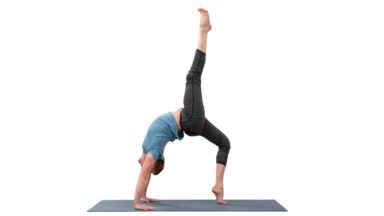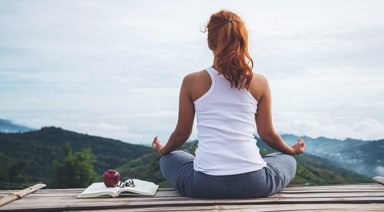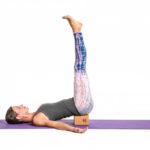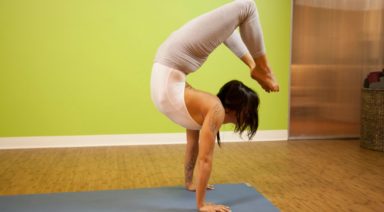Dangers of Lumbar Flexion in Yoga

Consider the number of times you flex forward at the waist or hips in a yoga class. Lower back flexion in yoga presents a number of risks when done improperly. We often hear our yoga teacher telling us to hinge at the hips instead of the lower back. Let’s consider what these cues really mean and offer in creating a safe forward bending yoga posture. First of all we have to go through a bit of yoga anatomy and biomechanics to understand the issues involved in this common movement.
Our spine is composed of twenty-four mobile vertebrae. The cervical spine includes the top seven vertebrae, while the thoracic spine is made up of the middle twelve, and the lumbar spine completes the count with the bottom five. Below the last lumbar vertebrae are the sacrum and coccyx. The sacrum is a triangular shaped bone that is actually the fused remnant of five sacral segments. The coccyx, also known as our “tailbone,” is an even smaller triangular bone that sits below the sacrum.
Both our cervical and lumbar spines take on a curve that is known as a lordosis. This lordosis essentially means that the cervical and lumbar curves’ concave sides face the front of the body; while our thoracic curve’s concave side faces the back of our body.
In-between each vertebra is an intervertebral disc. The basic functions of the discs are to act as vertebral shock absorbers and as spacers for the spinal nerves to exit the bony vertebral column. Our spinal cord runs down the inside of our vertebrae; each spinal nerve that divides from the spinal cord supplies a particular part of the body with neurological function. This explains many of the symptoms people get when they herniate or bulge a disc (burning, aching, pins and needles, tingling, pain, and weakness through particular parts of the limbs).
Intervertebral discs are round in shape with thick outer borders and jelly-like contents within the border. Each time we bend forward at the low back, the back side (posterior side) of the disc weakens. Over time, with excessive lumbar spinal loading or flexion, the disc develops microtears. Sometimes, these microtears can produce symptoms that are relatively mild; however, when the tears become more significant, symptoms become quite severe. If the thick border has enough microtears or one large tear, the inner jelly-like substance can squish out of the tear to either chemically irritate or physically compress the spinal nerves that exit the spine off of the spinal cord.
How is this complicated anatomy relevant to yoga, picking up a piece of paper off the ground, or even bending over to brush your teeth? Lumbar flexion is the movement of bending forward at the low back while rounding the spine. Due to the lordosis (lumbar curve), this position of flexion increases the likelihood of intervertebral disc microtears which then increases the chances of disc irritation, bulging, and most severely, herniation. A disc injury is one you most definitely want to avoid as they are hard to recover from and they increase your chances of low back injury recurrence; never mind the fact that they cause a lot of pain and can cause symptoms severe enough to require surgery due to neurological complications.
You must now be wondering how to keep your back safe while bending forward either on your mat or in your activities of daily living. When you bend forward, think about keeping your buttocks out and maintaining the natural curve in your lumbar spine. When you are standing straight up and when you bend forward, your lumbar curve should not change shape (much). Hinge forward at your hip joints instead of at your lumbar spine. People always say, “I bend my knees when I flex forward so I am ok!” My answer to that is that you can flex your knees all you want, but if you flex your lumbar spine as well, your back is at risk of injury. If you have to pick something up off the ground, the best way to do it is to both flex your knees AND keep you buttocks out to maintain your lumbar curve.
These principles apply to yoga as we bend forward quite a bit while on our mats. The repetitive action of improper forward flexion is dangerous, so be aware of your lordosis while you flex forward in poses while on your feet, on your back, or on your buttocks. This is even something you should think about while sitting at work; if you slouch through your lumbar spine, you are loading the discs which in time leads to microtears.
Understand your lumbar lordosis as it is your power position in everything you do. Take care of your back by being aware of how you flex forward and never compromise your back to reach further on your yoga mat.
3 Exercises to Strengthen Your Hips and Balance Your Body

In yoga we often speak of tight hips, needing to open the hips, balancing the opening of our hips from side to side (etc), but there is more to a balanced body than open hips. We also need stability and support from our hips. This is important not only in yoga but also in day-to-day activities like simply walking. It is especially important if you are an athlete and need to perform on one leg.
A Look Inside the Hip Our hip musculature is made up of many muscles, large and small. For stability, we need the muscles of the side of the hip to be active and engaged. If you place your hands on the sides of your bony pelvis below your waist, you can imagine a tear-drop-shaped area below the ridge of your pelvis. The front part of the tear is the Tensor Fasciae Latae or TFL which connects with your IT band to join at the knee. At the back part of the teardrop are the Gluteus Medius and Minimus, which lie underneath your big Gluteus Maximus.
These muscles are what support and keep you steady in balance poses or when you transfer weight from one leg to the next as you walk or run. For many of us, these muscles are fast asleep, so we recruit our hip flexors at the front or our glutes and our hamstrings at the back to do a job they were not designed to do. Over time this can lead to low back pain and sacroiliac joint pain. Forcing our body to compensate will lead to problems over time. A look outside the hip Tree pose can be a simple test to see if we are accessing our side/lateral hip stabilizers.
Stand in front of the mirror and take a medium-size tree pose with your foot resting on the shin (even if you can go higher). Place your hands on your bony pelvis again and see if they are level from side to side. If not, press the shin into the foot and the foot back into the leg so that the standing hip drops to make the hips level. If this is too difficult to achieve, keep your foot off the ground but come out of tree pose so that your knee is facing forward, raised to hip level with the knee bent.
Try to level the hips again here by firmly rooting into the ground with the standing leg. My Three Favorite Lateral Hip Exercises Most of us can benefit from a little extra love and attention to the side of our hips. Try these exercises to wake up your hips and begin to stand taller on one leg
1. Kick the Ball Standing: Lift one foot off the ground. Keep your leg straight and send your heel forward, toes pointing out as if you were passing a soccer ball in slow motion. Reverse this motion by turning your toes in and sending your leg behind you. Flow forward and back, heel in and out, in a short arc. Don’t forget about your standing leg: root into the earth and don’t let the hip hitch out to the side. Repeat this motion ten times and then switch sides.
2. Clam Shell: Lie on your side with either your arm or a foam block supporting your head. Bend both hips to 90 degrees with knees bent, feet touching, stacked on top of each other. Slowly lift your top knee up towards the sky while keeping your feet together (as if you were a clamshell opening). Keep your hips stacked and avoid rotating with the pelvis. Lower, repeat times, and switch sides.
3. Bicycle: Lie on your side with both legs straight. Flex your feet, as if standing, and stack them on top of each other. Lift your top leg so that feet are hip-width apart. Keep this distance as you flow through this sequence: a) knee bent move forward to the hip at 90 degrees, b) straighten at the knee, c) float straight leg back to start. This should look like you are slowly pedaling a bike. Keep the hips stacked and stable. Strengthening our lateral hips will not only improve our yoga practice, but will also balance our body and prevent injury so that we continue to walk, vinyasa, and run for years to come.





































